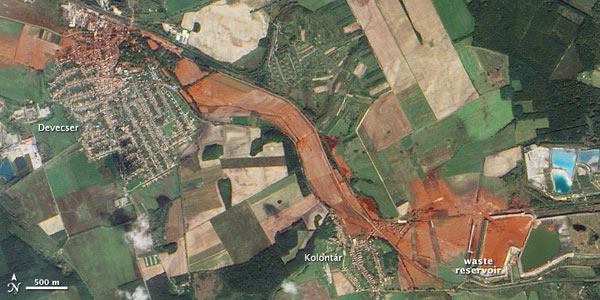Science News
Hungary's Toxic Sludge

The toxic sludge that burst out of its containment pond last week in Hungary sounds a lot like a bad science fiction/horror film. Sadly, it’s a true disaster that continues to cause problems as it flows into the Danube River this week.
It’s drowned and killed at least seven people, burned over 100, and has killed all of the wildlife in the Marcal River. From today’s New Scientist:
The high alkalinity of the sludge is the major problem for wildlife. Fish and other river-dwelling animals are sensitive to the pH of the water they live in, and in many cases even small shifts can be enough to kill them.
It’s affecting the soil and its inhabitants as well, according to János Szépvölgyi, director of the Hungarian Academy of Science's Institute of Materials and Environmental Chemistry, quoted in Nature:
All life is dead. A two- to five-centimeter-thick layer of caustic mud is covering the soil. The mud needs to be physically collected and removed — this will take a long time.
Part of the delay in the clean-up effort, according the same article in Nature, is understanding the content of the red sludge. An article on Life’s Little Mysteries breaks down its basics:
The sludge is aptly called "red mud" by those who work with it industrially, and is a solid waste product made during the production of alumina, or aluminum oxide. The stuff is made mainly of iron oxide particles, which give the slurry gets its hue, according to [Satish] Chandra.
But the levels of the chemicals can vary. An analysis by Greenpeace shows that the levels of arsenic in the escaping mud to be twice as high as expected, and it contains high levels of mercury and chromium, as well. Other scientists dispute these findings. Discover’s 80beats blog states that it could be that “The alumina plant may have mixed its industrial wastes.” (The blog also has some amazing photos of the destruction.)
The Hungarian government has assured that analyses will be ongoing.
A scientist at Indiana University may have a solution for these containment ponds in the future: a patent-pending type of carbon sequestration. The researcher, geologist Chen Zhu, is quoted in a ScienceDaily press release:
We propose one way to reduce the pH of bauxite residue is to mix it with another kind of industrial waste -- oil-field brine, which is a by-product of oil and gas production -- and then carbon dioxide.
(Check out the release for more details…)
Meanwhile, the alumina plant's CEO has been arrested, Greenpeace warns of contaminated drinking water and Hungarian officials worry about additional sludge leaks. How will this horror story end?